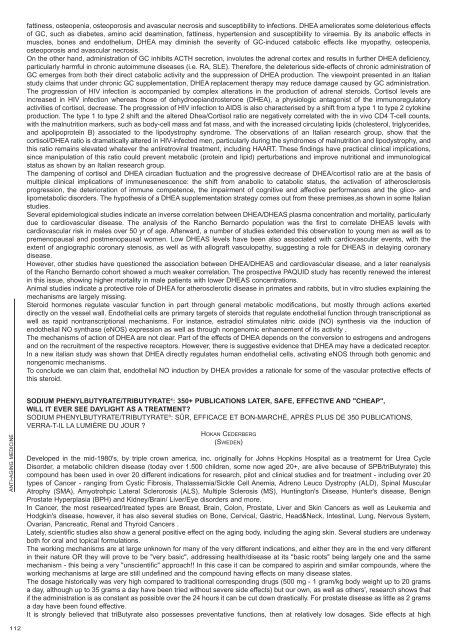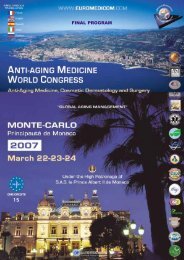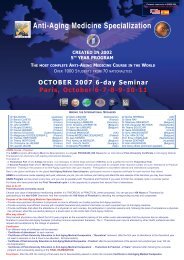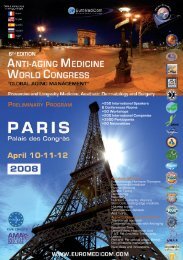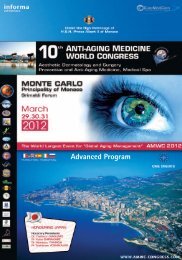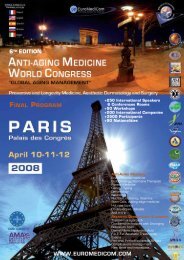FINAL PROGRAM 6TH EDITION - EuroMediCom
FINAL PROGRAM 6TH EDITION - EuroMediCom
FINAL PROGRAM 6TH EDITION - EuroMediCom
Create successful ePaper yourself
Turn your PDF publications into a flip-book with our unique Google optimized e-Paper software.
fattiness, osteopenia, osteoporosis and avascular necrosis and susceptibility to infections. DHEA ameliorates some deleterious effectsof GC, such as diabetes, amino acid deamination, fattiness, hypertension and susceptibility to viraemia. By its anabolic effects inmuscles, bones and endothelium, DHEA may diminish the severity of GC-induced catabolic effects like myopathy, osteopenia,osteoporosis and avascular necrosis.On the other hand, administration of GC inhibits ACTH secretion, involutes the adrenal cortex and results in further DHEA deficiency,particularly harmful in chronic autoimmune diseases (i.e. RA, SLE). Therefore, the deleterious side-effects of chronic administration ofGC emerges from both their direct catabolic activity and the suppression of DHEA production. The viewpoint presented in an Italianstudy claims that under chronic GC supplementation, DHEA replacement therapy may reduce damage caused by GC administration.The progression of HIV infection is accompanied by complex alterations in the production of adrenal steroids. Cortisol levels areincreased in HIV infection whereas those of dehydroepiandrosterone (DHEA), a physiologic antagonist of the immunoregulatoryactivities of cortisol, decrease. The progression of HIV infection to AIDS is also characterised by a shift from a type 1 to type 2 cytokineproduction. The type 1 to type 2 shift and the altered Dhea/Cortisol ratio are negatively correlated with the in vivo CD4 T-cell counts,with the malnutrition markers, such as body-cell mass and fat mass, and with the increased circulating lipids (cholesterol, triglycerides,and apolipoprotein B) associated to the lipodystrophy syndrome. The observations of an Italian research group, show that thecortisol/DHEA ratio is dramatically altered in HIV-infected men, particularly during the syndromes of malnutrition and lipodystrophy, andthis ratio remains elevated whatever the antiretroviral treatment, including HAART. These findings have practical clinical implications,since manipulation of this ratio could prevent metabolic (protein and lipid) perturbations and improve nutritional and immunologicalstatus as shown by an Italian research group.The dampening of cortisol and DHEA circadian fluctuation and the progressive decrease of DHEA/cortisol ratio are at the basis ofmultiple clinical implications of immunesenescence: the shift from anabolic to catabolic status, the activation of atherosclerosisprogression, the deterioration of immune competence, the impairment of cognitive and affective performances and the glico- andlipometabolic disorders. The hypothesis of a DHEA supplementation strategy comes out from these premises,as shown in some Italianstudies.Several epidemiological studies indicate an inverse correlation between DHEA/DHEAS plasma concentration and mortality, particularlydue to cardiovascular disease. The analysis of the Rancho Bernardo population was the first to correlate DHEAS levels withcardiovascular risk in males over 50 yr of age. Afterward, a number of studies extended this observation to young men as well as topremenopausal and postmenopausal women. Low DHEAS levels have been also associated with cardiovascular events, with theextent of angiographic coronary stenosis, as well as with allograft vasculopathy, suggesting a role for DHEAS in delaying coronarydisease.However, other studies have questioned the association between DHEA/DHEAS and cardiovascular disease, and a later reanalysisof the Rancho Bernardo cohort showed a much weaker correlation. The prospective PAQUID study has recently renewed the interestin this issue, showing higher mortality in male patients with lower DHEAS concentrations.Animal studies indicate a protective role of DHEA for atherosclerotic disease in primates and rabbits, but in vitro studies explaining themechanisms are largely missing.Steroid hormones regulate vascular function in part through general metabolic modifications, but mostly through actions exerteddirectly on the vessel wall. Endothelial cells are primary targets of steroids that regulate endothelial function through transcriptional aswell as rapid nontranscriptional mechanisms. For instance, estradiol stimulates nitric oxide (NO) synthesis via the induction ofendothelial NO synthase (eNOS) expression as well as through nongenomic enhancement of its activity .The mechanisms of action of DHEA are not clear. Part of the effects of DHEA depends on the conversion to estrogens and androgensand on the recruitment of the respective receptors. However, there is suggestive evidence that DHEA may have a dedicated receptor.In a new italian study was shown that DHEA directly regulates human endothelial cells, activating eNOS through both genomic andnongenomic mechanisms.To conclude we can claim that, endothelial NO induction by DHEA provides a rationale for some of the vascular protective effects ofthis steroid.ANTI-AGING MEDICINESODIUM PHENYLBUTYRATE/TRIBUTYRATE ® : 350+ PUBLICATIONS LATER, SAFE, EFFECTIVE AND "CHEAP",WILL IT EVER SEE DAYLIGHT AS A TREATMENT?SODIUM PHENYLBUTYRATE/TRIBUTYRATE ® : SÛR, EFFICACE ET BON-MARCHÉ, APRÈS PLUS DE 350 PUBLICATIONS,VERRA-T-IL LA LUMIÈRE DU JOUR ?HOKAN CEDERBERG(SWEDEN)Developed in the mid-1980's, by triple crown america, inc. originally for Johns Hopkins Hospital as a treatmernt for Urea CycleDisorder, a metabolic children disease (today over 1.500 children, some now aged 20+, are alive because of SPB/triButyrate) thiscompound has been used in over 20 different indications for research, pilot and clinical studies and for treatment - including over 20types of Cancer - ranging from Cystic Fibrosis, Thalassemia/Sickle Cell Anemia, Adreno Leuco Dystrophy (ALD), Spinal MuscularAtrophy (SMA), Amyotrohpic Lateral Sclerorosis (ALS), Multiple Sclerosis (MS), Huntington's Disease, Hunter's disease, BenignProstate Hyperplasia (BPH) and Kidney/Brain/ Liver/Eye disorders and more.In Cancer, the most researced/treated types are Breast, Brain, Colon, Prostate, Liver and Skin Cancers as well as Leukemia andHodgkin's disease, however, it has also several studies on Bone, Cervical, Gastric, Head&Neck, Intestinal, Lung, Nervous System,Ovarian, Pancreatic, Renal and Thyroid Cancers .Lately, scientific studies also show a general positive effect on the aging body, including the aging skin. Several studiers are underwayboth for oral and topical formulations.The working mechanisms are at large unknown for many of the very different indications, and either they are in the end very differentin their nature OR they will prove to be "very basic", addressing health/disease at its "basic roots" being largely one and the samemechanism - this being a very "unscientific" approach!! In this case it can be compared to aspirin and similar compounds, where theworking mechanisms at large are still undefined and the compound having effects on many disease states.The dosage historically was very high compared to traditional corresponding drugs (500 mg - 1 gram/kg body weight up to 20 gramsa day, although up to 35 grams a day have been tried without severe side effects) but our own, as well as others', research shows thatif the administration is as constant as possible over the 24 hours it can be cut down drastically. For prostate disease as little as 2 gramsa day have been found effective.It is strongly believed that triButyrate also possesses preventative functions, then at relatively low dosages. Side effects at high112


